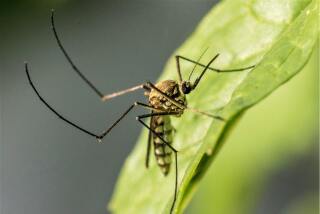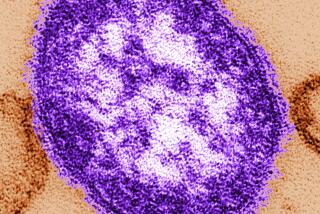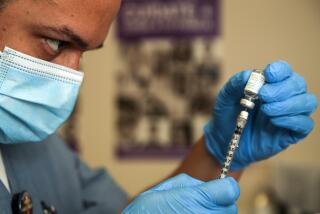Measles Epidemic Blamed in Deaths of Two Toddlers
Two toddlers who died suddenly Thursday night in Hacienda Heights were probably the latest victims of a Southland measles epidemic that killed two children last year in Los Angeles and two others in Long Beach earlier this month, health officials said Friday.
Los Angeles County reported 513 cases of red rubeola measles last year, up from 69 in 1987 and 40 in 1986. The Centers for Disease Control in Atlanta said this is more than 17% of the 2,933 cases nationwide and constitutes a risk for Angelenos that is 5.3 times higher than in the rest of the country.
“Los Angeles has a measles epidemic,” said Dr. Loring Dales, chief of the immunization unit for the state Department of Health Services. “The disease has permanently established itself in Los Angeles County . . . and has spread into Orange County, Riverside and San Bernardino counties.”
Dr. Shirley Fannin, who is in charge of communicable diseases for Los Angeles County, said, “We’ve had more measles in the last year and a half than we’ve had in the last 10 years,” she said
The last four children who died were of Samoan descent and under the age of 3. Their families worshiped in close-knit congregations at Samoan churches in their respective neighborhoods.
Authorities said eight children were rushed by paramedics to local hospitals Thursday night after a gathering at the First Samoan Assembly of God Church in Hacienda Heights. Victoria Foa Foa and Maeli Lotoa, both 2, died almost immediately, with a “preliminary diagnosis of measles,” Fannin said. Autopsy results are pending.
Doctors at Childrens Hospital of Los Angeles definitively diagnosed measles in the other six children, who were hospitalized there Friday.
Measles has gained its strongest foothold among poor ethnic minorities, attacking their youngest children, who are most vulnerable to the high fever and bronchial infection associated with the disease. Rubeola measles usually runs a 10-day course, as opposed to the German measles, or rubella, which lasts about three days.
“It’s the kind of measles you see in Third World countries,” Dales said of the rubeola epidemic.
The measles vaccine--discovered more than two decades ago--is provided free at county health clinics to all children over the age of 1. But Dales said that only 35% to 50% of the children in poor neighborhoods are being vaccinated before the age of 2.
“We’ve got a problem, and we don’t know how to lick it,” he said. In the past, Dales said, Los Angeles has experienced “episodic outbreaks that had flared up and then been stopped.” He said the tenacity of the most recent epidemic suggests that measles has permanently established itself here in much the same way that it has in developing countries.
Although the disease has been associated in this country with its periodic attacks on hardy elementary school-age children, Dales said its fury has been directed recently at infants and toddlers who are much more vulnerable.
“We are finding that because the children are so young, one in every four cases needs hospitalization.”
‘It Really Took Off’
Epidemiologists in Los Angeles began in August, 1987, to carefully watch the measles that surfaced and “sputtered and flared here and there around the county until May of 1988, when it really took off,” he said.
The disease, he said, “raged through the summer and into the fall,” concentrated mainly among preschool children in the Latino community of central Los Angeles. Two children under the age of 2 died from the measles, he said.
“In the Hispanic community, most kids have not been vaccinated,” said Dr. Stephen Waterman of the County Department of Health Services.
“A lot has to do with their immigration status, their fear of institutions and the lack of access to medical care in general for them,” he said. Early this year, measles apparently leaped from the Latino community to Samoans living in north Long Beach.
Long Beach health officials report 38 cases of measles since the first of the year--and 32 of the victims have been Samoan. Three-year-old James Faumui and Faamatua Moeola, 18 months old, died of measles earlier this month, according to Bob Salcido, chief epidemiologist with the Long Beach Department of Health and Human Services. Autopsy results that may confirm those findings are not yet available.
Susceptible Population
“What we have is a very susceptible group that has not been immunized,” Salcido said. “In general, Pacific Islanders are very prone to respiratory infections (including measles) and, when they do get an infection, it can complicate very quickly.
Most of the Long Beach measles victims, Salcido said, are affiliated with the United Samoan Assembly of God in Long Beach.
One of the toddlers who died Thursday in Hacienda Heights was treated by paramedics at the church there. The other was treated by paramedics at a house a block away. Family members there declined to be interviewed.
A county Fire Department spokeswoman said all of the children who became ill Thursday night had recently attended an unspecified church function. She said the Sheriff’s Department was attempting to find everyone who had been at the function and had discovered that most families were from the surrounding neighborhood but that one lived in Compton.
Funeral for a Child
A woman who would not give her name but identified herself as an aunt of one of the dead children said there had been a funeral for another child at the church on Wednesday.
Five of the six children who were hospitalized Thursday night remain at Childrens Hospital in fair condition. One was released Friday. The ages of the six range from 1 to 11.
Staff writers David Haldane, Edmund Newton and Alan Parachini contributed to this article.
MEASLES CASES Incidence of measles as reported to the Los Angeles County Health Dept. 1984: 213 1985: 44 1986: 40 1987: 69 1988: 513 1989*: 61 * 1989 cases through Feb. 22 MEASLES: A DANGEROUS DISEASE Measles, technically called rubeola, a highly infectious viral disease characterized by a rash that covers the entire body. (German measles, or rubella, is a different, less common disease with similar symptoms.)
First symptoms: fever, cough, runny nose, watery eyes, sensitivity to light. Appear about 10 days after the virus enters the body. Rash appears four days later, persists five to 10 days.
No drugs to combat measles once it develops. Patients should be kept in bed and comfortable until symptoms disappear.
Measles strikes adults, but is more common among children. About one in 15 children who contract the disease develop complications ranging from infections of lungs (bronchitis and pneumonia) and ears to, in rare cases, brain infections. Incidence of complications is higher among children under the age of 2. When complications develop a physician should be contacted.
Disease remains infectious from time symptoms appear until a few days after rash has appeared. Spread primarily by coughing and sneezing. Virus particles in air or on surfaces can remain infectious up to 72 hours.
Before the 1960s, as many as 500,000 children in the United States caught measles each year. In 1963, American virologist James F. Enders developed a weakened form of the virus for use as a vaccine. By 1983, the number of cases nationwide had dropped to 1,497, before rising to 6,282 in 1986, the recent highpoint, and 2,933 in 1988.
Vaccine ineffective when given to infants younger than 6 months and only partially effective for those aged 6 months to 15 months. Last month, the U.S. Centers for Disease Control recommended infants receive vaccine at 9 months, with second dose at 15 months. At schools with measles outbreaks, children who were vaccinated before 1980 or before the age of 15 months should receive a booster shot, the center said.
Los Angeles County residents can receive free vaccinations at any clinic of the Department of Health Services. For information, call (213) 974-7937.
More to Read
Sign up for Essential California
The most important California stories and recommendations in your inbox every morning.
You may occasionally receive promotional content from the Los Angeles Times.










